Born on this date in 1946, Tom Reid had a 12 year NHL career that started with the Chicago Black Hawks.
Tom Reid with the Black Hawks
Reid, a defenseman played for the St. Catharines Black Hawks of the Ontario Hockey Association from 1964-65 to 1966-67. A defensive defenseman, Reid is described in his biography on the Hockey Hall of Fame's Legends of Hockey website as "a stay-at-home defender who viewed the offensive zone as a distant moon"!
He graduated from junior hockey just as the NHL expanded from six teams to 12 and landed a spot on the Chicago blueline with 56 games in his rookie season of 1967-68 as well as seeing his first taste of playoff action with nine postseason games. After 30 games with Chicago in 1968-69, he was traded to the Minnesota North Stars on Valentine's Day in 1968. In all, he played 86 games for the Black Hawks, totaling seven assists.
Reid competed in the final 18 games of the North Stars schedule and established himself as a regular the following season with 66 games played, which included his first NHL goal.
The 1970-71 season saw his offensive output leap up to 17 points, more than double his previous high of eight. Additionally, the North Stars would make a push in the playoffs, first defeating the St. Louis Blues in six games before stretching out the eventual champion Montreal Canadiens to six games for the right to play in the finals. The North Stars 6-3 Game 2 win in Montreal on April, 22 was the first time a 1967 expansion team had ever defeated an Original 6 club in the playoffs.
Tom Reid's 1970-71 rookie card
The 1971-72 season was the most remarkable of Reid's career. It saw the player once described as "a sort of third goal post, firmly anchored to his own zone" go on a goal scoring binge, as he netted six for a career high, including by far the most memorable goal of his career.
Reid doing his best imitation of a third goal post
On October 14, 1971 Tom Reid scored on a penalty shot against Hall of Famer Ken Dryden of the Canadiens. It was scored by the most unlikely of sources, a man who only scored 17 goals in his entire career and the only penalty shot ever scored against Dryden!
Let's not forget the shot that was heard around the world. Well, maybe just the hockey world. Allan Thomas Reid was not a prolific scorer among NHL defensemen. In a span of 10 shin-bruising seasons with the North Stars, Tall Tommy scored only 17 goals, but on the night of October 14, 1971, he performed a feat that put him in a class by himself and earned him a place in the team history book. On one of his rare good scoring opportunities, Reid was fouled by a Montreal player and the referee awarded him a penalty shot.
Coach Jack Gordon, showing supreme confidence in Reid's scoring prowess, asked the ref, "Does Reid have to take the shot?" To young Thomas that was the ultimate insult, but take the shot he did. Unleashing all of his anger over the coach's lack of confidence, Reid launched a blistering rocket that left Ken Dryden trembling in his skates. The twine behind Dryden bulged, the red light flashed, bells chimed, fireworks filled the air, brass bands started playing, an thousands of fans began chanting, "Tommy! Tommy! Tommy!" And so, a hero was born on that autumn evening, many years ago.
Reid's own version of the event naturally differs slightly from Shavers.
I came out of the penalty box and was heading toward the bench when a clearing pass hit my skate and careened toward the Montreal zone. Instead of going to the bench I went after the puck and had a clear breakaway. Guy Lapointe tripped me from behind and I slid hard into the boards.
Referee Bruce Hood skated over and asked if I was okay. I said "Yes," and then, "You're giving him a penalty, right?" He said, "You're getting a penalty shot." I said: "Bruce, go to hell. I don't want a penalty shot." "You got one," he replied.
When I got to the bench, coach Jack Gordon asked what was going on. Hood skated over and said, "Let's go." Jack said, "What do you mean?" and was then informed of the penalty shot. Jack said, "Does he have to take the shot?" and I informed Hood that I thought my leg was broken. Hood said, "Let's go or you'll get a delay of game."
Everyone on the bench was giving me advice about what to do with the shot, but J. P. Parise simply said, "Put the damn thing behind him."
I was so focused as I got ready to take the puck that I couldn't hear a thing. There were 15,000 people in the building, but I heard nothing. It was a warm October night so the ice was a bit wet, and I was worried about carrying the puck across the blue line. My main concern was just getting off a shot.
I skated in, got to the high slot, and shot the puck. Ken Dryden wasn't expecting a shot that quickly and he overreacted. I was aiming for the corner, but the puck went between his legs and into the net, my big claim to fame.
When I got back to the bench, I said to Jack, "Was there ever any doubt?"
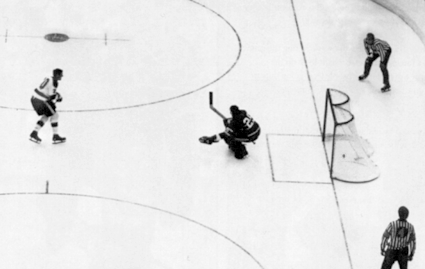
Tom Reid's famous penalty shot goal against Ken Dryden
Reid's 21 points for the season also raised his career best in that category as well. Additionally, his 107 penalty minutes established a career high. In the postseason, Reid scored the only playoff goal of his career against the Blues to cap off a most memorable season.
Two seasons later, Reid set a career hight with 23 points from four goals and a career best 19 assists in 76 games. He stayed true to his defensive roots the following season, again topping 70 games for the fourth time in five seasons with 74 games played, but managed just six points while leaving the point gathering to teammates Dennis Hextall (74 points) and Bill Goldsworthy (72). He did top 100 penalty minutes for only the second and final time in his career with 103.
Reid competed in 69 games in 1975-76, contributing 15 assists and 54 games in 1976-77, adding another eight assists to his career total.
It was around this time that Reid developed a small red rash on his arm, which itched terribly as his skin began to deteriorate. Eventually the condition was given the name "gunk". Eventually league doctors, trainers and equipment manufacturers began to investigate and discovered that about 100 players across the NHL were suffering from various degrees of the same condition, but none as severe as Reid's, whose skin eventually got so bad that he could only sleep sitting upright in a wooden chair.
The condition was so severe, Reid was forced to retire after managing to play only 36 games of the 1977-78 season, in which he scored his final NHL goal and added six assists to push his career totals to 690 games played, 17 goals and 113 assists for 130 points as well as 42 playoff games with one goal and 13 assists. Doctors finally concluded that Reid's rash was caused by allergies to his hockey equipment and the dye in his jersey.
Former teammate Lou Nanne relates a story about Reid and his noted sense of humor:
Tom Reid was a terrific defensive defenseman. He was very consisent - game in and game out you knew you going to get strong defense from Tommy. His play never varied.
I had three concussions in my career. The third one was the result of a real good check by Dennis Owchar one night in Pittsburgh. At the doctor's suggestion, I had started wearing a helmet after my second concussion to help prevent further ones.
But this night in Pittsburgh I was playing defense with Tom Reid, and I was carrying the puck up the ice. I thought I had made a real good move to get by Owchar, but as I slipped the puck though his legs to try to go around him, he hit me with a shoulder right between my shoulder blades and I went down very hard. I hit my head on the ice so hard I eventually had seven stitches, even with the helmet.
I tired to get up, was real dizzy and started going back down again. The next thing I know, the trainer, Doc Rose, is on the ice telling me to lie down, that they're going to carry me off.
I said, "There's no way. I've never been carried off the ice, and I'm not going to let anybody carry me off now."
I tried to get up again, and I went right back down. And as I'm going down this time, Tom Reid leans over and says. "Louie, Louie, before you go, can I have your condominium in Florida?"
Since his retirement from hockey, armed with that same sense of humor, he has worked as a color analyst for the North Stars, Minnesota Gophers and now the Minnesota Wild. He is also the president of the North Stars Almuni Chapter and owner of Tom Reid's Hockey City Pub, the place to meet before and after Wild home games down the street at the Xcel Energy Center and site of the annual Hockey Collectors Expo, next scheduled for Sunday October 3rd from 11 AM to 6 PM, where local collectors share their game worn jersey collections.
Today's featured jersey is a 1973-74 Minnesota North Stars Tom Reid jersey. This was the third style of green jersey worn by the North Stars, with the original having a lace up collar, which was dropped during their first season for a v-neck collar. Starting in season two in 1968-69, a white shoulder yoke was added to the jerseys. This third style remained in use through the 1974-75 season.
Our video section today begins with a look at the 1975-76 Minnesota North Stars, some of the crappiest, most annoying filmmaking in the history of sports. If you choose to suffer though Part 1, I recommend skipping ahead to the 3:58 mark. Perhaps Parts 2 through 5 improve after getting past the first half of Part 1. You click the link, you take your chances...

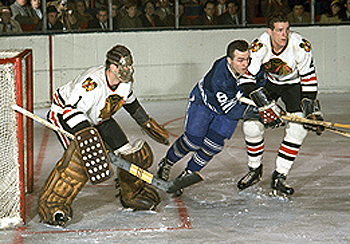
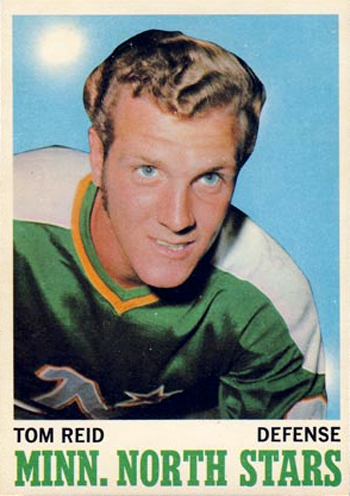
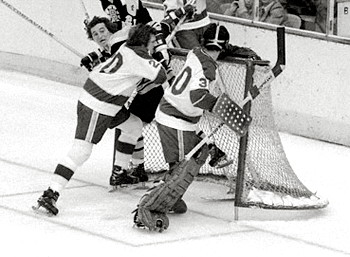

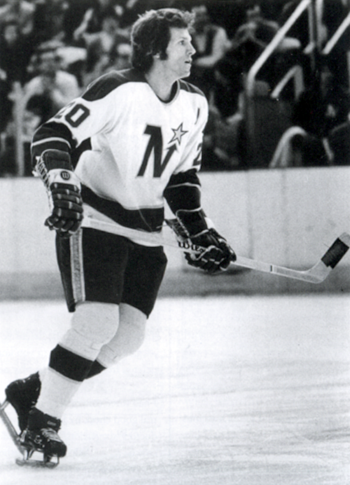
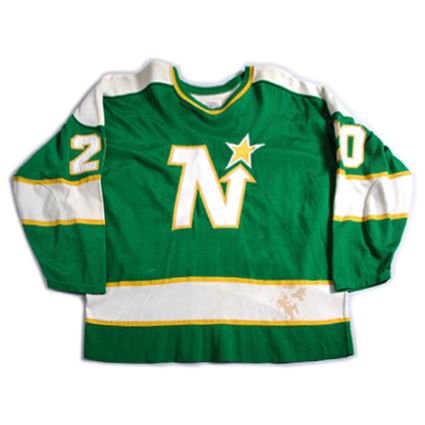











No comments:
Post a Comment
We welcome and encourage genuine comments and corrections from our readers. Please no spam. It will not be approved and never seen.